| MD: You mention in “Back to the Turmoil” that you wrote on women artists before you discussed sexuality and representation more explicitly in your work. This is something you could say about Craig Owens’s work as well. Were women artists and feminist art a starting point for your writing on sexuality? DC: In fact, it was more than that. Around the time that I was reading these first “gay liberation books”, I was also reading feminist books. I read Kate Millet, Germaine Greer – the early books of second-wave feminism. It was very easy to read those as being about yourself if you were gay. When you read analysis of misogyny or patriarchy, as a gay man you understand your relationship to it easily. |  | 
| 
|  |  | Craig got involved with feminist theorists in the art world, and he was one of the first men to do so. He wrote some of the early crucial feminist texts in the early and mid ’80s, like “The Discourse of Others: Feminists and Postmodernism”. The anthology it was in, The Anti-Aesthetic, came out in 1983. So I guess it was gestating for a long time. We were interested in aspects of recognizable gay culture. I’d read Jean Genet in college, and I’ve always been a great fan of Pasolini. In fact, one of the first things that I wrote about sexuality, before the AIDS issue of October, was published in the first volume of Dia conversations, which was about art in the public sphere.[8] I talked about something that is not unlike the metaphor of the back room at Max’s, oddly enough, now that I think about it. There was a show at the New Museum called “Homo Video” that Bill Olander had curated. It had some of the first AIDS-tapes that I’d seen, such as Stuart Marshals’ Bright Eyes (1986), the pilot for Testing the Limits (1987), and Todd Haynes’s Superstar: The Karen Carpenter Story (1987) – the beginnings of what we now see as queer film. At the same time, there was major Hans Haacke retrospective in the New Museum’s main galleries. So I talked about the fact that the museum had staged these two shows, with two different notions of political art practice, in two separate spaces – with no mediation at all. It was like the back room was “Homo Video”, and the front room was Hans Haacke. So “gay” and “straight” were spatially separated – it’s basically the same story as the front and back room at Max’s. |  | 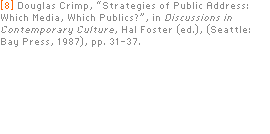
| 
|  |  | 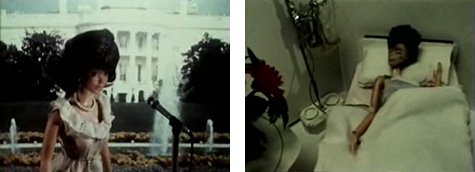
|  | | 
|  |  | 
|  |  | 
|  |  | This is the place, after the Fassbinder essay, in which I first discuss gay politics. In fact, I quote Pasolini in this essay. It’s one of my favorite statements, from his Lutheran Letters. Pasolini says that “tolerance is always and purely nominal. I do not know a single example of real tolerance. That is because real tolerance would be a contradiction in terms. The fact that someone is ‘tolerated’ is the same as saying that he is ‘condemned’.”[9] What he’s saying, obviously, is that tolerance is asymmetrical. I think that was my first foray into talking about my own subject position as a gay man writing criticism in the art world. And this was in a powerful art-world institution – the Dia Art Foundation – with critics like Thomas Crow and Benjamin Buchloh, important voices in the art discourse at that time. |  | 
| 
|  |  | 
MD: This was in 1986, a year before you did the special issue of October on AIDS. When did you start working at October? DC: I started in 1977 with issue number 4. October was founded in 1976 by Rosalind Krauss, Annette Michelson, and the “forgotten figure” of the crew – Jeremy Gilbert Rolfe, who was pushed out very early on. Until MIT Press became the publisher and I was hired, October had been not published regularly. MD: You were a student of Rosalind Krauss? DC: Yes. When I went back to graduate school I went to the CUNY Graduate Center, where Rosalind Krauss was teaching. I had met Rosalind shortly after she came to New York, which was around 1971. Before that she had been in Cambridge. I didn’t know her well, but I had met her and I knew her work. CUNY had a unique graduate program where you could actually work on contemporary art and criticism, rather than history. By the spring of ’77 Rosalind asked me to be the managing editor of October, and eventually I was promoted to senior editor, and then to being one of the full editors. And that was pretty much the entire staff for the time that I was there, but for a very short time when Craig Owens was associated with the journal, and eventually Joan Copjec came on as an associate. And then all of those other guys came after I left: Benjamin Buchloh, Yve-Alain Bois, Denis Hollier, Hal Foster. They had all had an association with the journal – all of them had published in it. I had brought Benjamin to the journal. Yve-Alain was a friend of Rosalind’s. Eventually Denis Hollier became Rosalind’s husband, so he came after I left. But basically, I always claim that when I left October it took five straight white men to replace me. (laughter) |  | 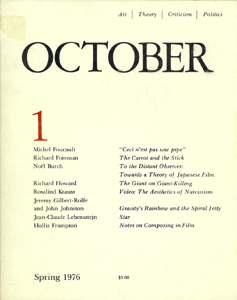

| 
|  |  | 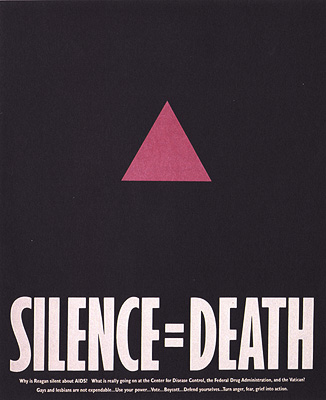
|  | | 
|  |  | 
|  |  | 
|  |  | MD: Let’s talk about the special issue of October that you edited in 1987 – AIDS: Cultural Analysis/Cultural Activism. This is often said to be one of the early founding moments of queer theory, as well as an important moment in the AIDS chronology from a cultural perspective. DC: AIDS: Cultural Analysis/Cultural Activism represented two things: One was that it made AIDS something that people in the academy could consider, using the postmodern theory that we were all involved with at that time. We could begin analyzing representations of AIDS – artistic representations, but also media representations, science, and so on. Simon Watney had already published Policing Desire – Pornography, AIDS and the Media (1987), so there were precedents for what the October issue did. In fact, Leo Bersani’s famous essay “Is the Rectum a Grave?” was originally commissioned by me as a review of Watney’s book. I asked Leo if he would review Policing Desire, and he said that he had to think about it. In the end, he produced not a review, but a seminal queer-theoretical text. The second thing the special issue represented was a combination of activist and academic perspectives. I initially planned to approach AIDS from within October’s usual purview – how the art world was dealing with AIDS. I’d thought of doing a few essays, but I didn’t know what I was getting into. Around that time I saw the pilot of Testing the Limits, and I met a member of the video collective who produced it, Gregg Bordowitz. Gregg said to me “if you really want to know about AIDS you have to go to ACT UP”. This was right after ACT UP had been founded in March of 1987. I started going to ACT UP meetings, and I got hooked. I went one week, and I never stopped, at least until the group began to fall apart. Going to ACT UP meetings made for a very fast AIDS education. I got to know Gregg and asked him to write something for the issue, and the whole thing mushroomed from there and grew into special issue. I was given permission by my fellow editors to do a special issue, but then it just got bigger and bigger. We initially wanted to publish it as a double issue, but MIT wouldn’t allow double issues, so it just became a big issue, twice as big as most October issues. |  | 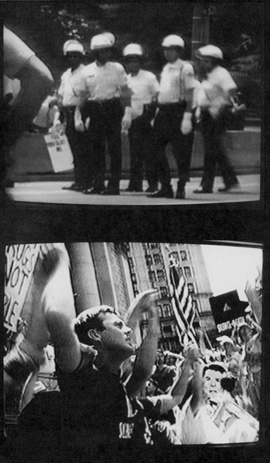

| 
|  |  | 
|  |  |
|